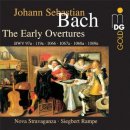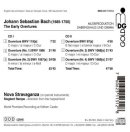|
|
Orchestral Suites BWV 1066-1069
Siegbert Rampe (Conductor)
Review: Early Overtures
|
C-1 |
J.S. Bach: The Early Overtures |


|
|
CD-1 [53:42]:
Overture from Cantata BWV 119[a], reconstructed by Siegbert Rampe [7:32]
Ouverture (No. 1) BWV 1066, in C major [21:40]
Ouverture (No. 2) BWV 1067[a], in A minor, reconstructed by Siegbert Rampe [24:08]
CD-2 [47:58]:
Overture from Cantata BWV 97[a], reconstructed by Siegbert Rampe [4:50]
Ouverture (No. 3) BWV 1068[a], in D major, reconstructed by Siegbert Rampe [21:43]
Ouverture (No. 4) BWV 1069[a], in D major, reconstructed by Siegbert Rampe [21:07] |
|
Siegbert Rampe (Conductor & Harpsichord) |
|
Nova Stravaganza (on period instruments) [Pitch: a' = 394 Hz] |
|
- |
|
MDG Gold MDG-3411131-2 |
Sep 24 & 28-30, 2001 |
2-CD / TT: 101:40
MP3 / TT: 53:34 |
|
Recorded at Spiegelsaal Schloss Köthen (Anhalt), Saxony-Anhalt, Germany.
Recording Reviews: Review: Early Overtures
Listen on YouTube:
I. Ouverture in C-Major, BWV 119[a] & II. Ouverture in B-flat Major, BWV 97[a] [12:42]
Buy this album at:
2-CD (2002): Amazon.com | Amazon.co.uk | Amazon.de
Music Download: Amazon.co.uk | Amazon.de | iTunes |
Kirk McElhearn wrote (October 5, 2002):
Bach’s Orchestral Suites, or Overtures, are among the only true orchestral works he wrote for a chamber ensemble. With the exception of the Brandenburg Concertos, all his other orchestral works are for solo instruments, such as harpsichord or violin, and orchestra. The four overtures are tutti works, like the Brandenburgs, where the entire ensemble is the soloist. These works are also some of the most French of all of Bach¹s music - not only is the sound distinctly French, but the movements bear French names as well.
There are many unresolved issues around these works - when, exactly, they were written, how they were meant to be scored, and which versions of the existing copies are to be used. There are no autograph copies for any of these works, and this leaves them surrounded by many questions. Siegbert Rampe has been analysing these overtures to come up with what he considers ³early² versions of the works, which he has reconstructed from the various copies. In addition, he adds two individual movements that may have been part of other overtures; there has long been a question of why Bach only wrote four of these pieces.
In any case, these issues are interesting for musicologists, but for those seeking fine music played and recorded well, this set is exactly the answer. Rampe and his ensemble show a rare level of energy and vigour when playing these pieces, which are too often played laconically. The opening movement of the first overture is played with a great deal of finesse, and the tempo is agreeable energetic. The rest of the suite continues along these lines, with bright, snappy lines, and a truly regal sound. One can hear the French rhythms that give this music its unique character.
The long opening movement of the second suite, marked lentement, also gets the appropriate treatment, with its minor key giving it more gravity, but with the musicians performing brilliantly. The delightful rondeaux that follows - which calls forth images of men and women with powdered wigs dancing by candlelight - is well-articulated, and, again, has the right level of energy. One can feel in this, and in the other fast movements, such as the Bourrée, that Rampe truly understands this music. So many other performers play these movements with such gravity that they lose their rhythm, but here the music comes alive.
The famous air of the third suite (the Hamlet cigar music), has a nice round tone, with the violins playing softly yet clearly, and the accompaniment balanced perfectly. The fourth overture, played here by 3 oboes, bassoon, 2 violins and continuo, sounds a bit too large and unbalanced. The opening overture sounds a bit hesitant, and the mix of the instruments does not come through as well as the other suites. But it picks up again with the sprightly bourrée, where the oboes fit perfectly, and the overall volume allows all the instruments to come through clearly.
The sound of this recording, as with most MDG discs, is exemplary, with such perfect space and resonance; one can regret that the harpsichord sounds a bit buzzy at time. It is not clear whether this is because of the instrument or the way it is miked, but it does distract, especially when listening with headphones. But the instruments are all balanced perfectly, and the sound is a true delight.
This is an excellent recording, full of energy and liveliness, with excellent sound and a wonderfully bright approach to these works that are far too often staid and “orchestral”. Siegbert Rampe gives this music the treatment it truly deserves, putting in the right perspective and playing it with great affection.
Orchestral Suites BWV 1066-1069 : Orchestal Suites – Koopman | Orchestal Suites – Rampe
|
|
|